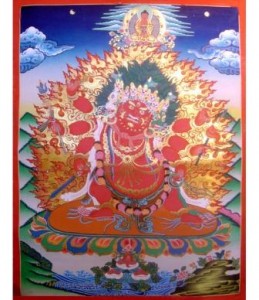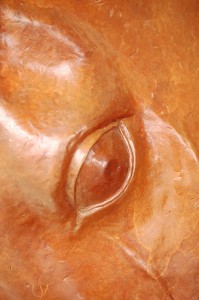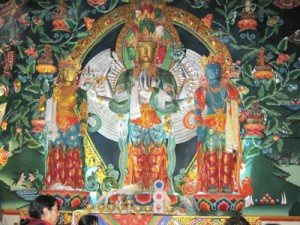Friday
Dharma TeachingsRiding the Powerful Steed of Compassion
Gesar’s Horse, Kyang Go Karkar
In many of the great stories and myths of the world, a powerful and intelligent horse plays a significant role. The hero or heroine rides the most magnificent of steeds like a throne which is alive with the power of the natural world. In Central Asian gravesites the bones of horses have been found side by side with the bodies of warriors, both male and female. Incredible gold ornaments — including saddles, girths, stirrups, and harnesses — have been uncovered. In Celtic lore, white horses — often depicted on the sides of mountains — still blaze as chariots of the sun. Siddhartha’s white horse was named Kanthaka. His energetic, wakeful hooves beat against the floor of the stable in Siddhartha’s palace to signal that it was time for the prince to become the Buddha. It is said that before the Epic of Gesar was first sung, a space was prepared for the event. Barley flower was scattered on the ground as an offering. “The audience sat around it. The bard recited the epic for several days. They say that the hoof prints of Gesar’s horse appeared in the prepared space.”
In the story of the birth of Gesar, published in the Shambhala Times yesterday, it was Hayagriva who empowered the hero’s magical horse, Kyang Go Karkar. We are staying with Gesar’s story for another day of our Harvest of Peace theme to continue the journey of exploring how to accumulate power in order to bring peace to the world. Mircea Eliade and other important thinkers write that great epics and motivating mythic tales of sacred heroes and heroines are introduced and then renewed in difficult times. In the time of Gesar, this power was accumulated and strengthened, which led to peace in Tibet. Today, we can look to this epic as a teaching story, rife with lessons for bringing peace to our own time and place.
The following is a retelling of a gorgeous episode in the Epic of Gesar about how his horse, Kyang Go Karkar, came to him when Gesar was 12 years old. After the story, we invite you to read a bit more about Hayagriva, design activities your family can do to encourage children’s relationship with their own horse, and explore further readings.
___________________________________
The Powerful Steed of Compassion
Gesar lived with his mother until he was six years old. He was named Choru, and his radiance and sacred nature was kept hidden until it came time for him to become the king. When he left his mother’s home, he went to the Mukpo region – which was barren at the time. With the help of formless beings, he built the celestial palace where he would later retire. In nearby Ling, maras – or demons — caused great storms and the people living there relocated to Mukpo. Until he was 11 years old, Choru’s displays of miraculous powers led these people to regard him as the little king of the empire.
When Choru was 12 years old, there was to be a competition – a horse race — held in Ling to determine who would become king. The prize would be the palace, power over all of its treasures, and the hand of Princess Drukmo.
Gesar’s powerful uncle had a vision: Gesar had to win the horse race. Until that time, Choru had not yet found the horse promised to him when he agreed to take rebirth. It was still running wild in the mountains. But just then — on its own — the steed raced to Choru, who recognized Kyang Go Karkar at once.Kyang Go Karkar could fly. But during the race, he trotted along with the other horses. His speed and stability were so excellent that he arrived first and the little king won. Twelve-year-old Choru sat on the golden throne of Ling.
It was then that he took his real name, Gesar Norbu Dradul: supreme one born in all the world; tamer jewel of all enemies. His form, which had been ordinary and sealed in secrecy until then, manifested clearly like an overcast sky suddenly giving way to brilliant sunlight. Gesar’s form was revealed to be imbued with all the irresistible nirmanakaya qualities.
From the skies, the gods rained down dharma substances. All the dralas and wermas offered silken white scarves. And Gesar’s steed, the magnificent white Kyang Go Karkar, stood up on his hind legs and pounded his hooves against a rock, revealing a secret door. Behind the door were all the warriors’ sacred outfits and treasures that had been hidden by Padmasambhava for this very moment.
Dressed and armed with these treasures, Gesar of Ling took his seat on the throne beside his beautiful and powerful queen-to-be, Princess Drukmo. Dressed in a chuba of brocade satin edged with otter fur, her hair in a hundred plaits gathered in a single braid and interwoven with ornaments of turquoise and coral.
The royal couple had arrived.
___________________________________
 WHO IS HAYAGRIVA?
WHO IS HAYAGRIVA?
Hayagriva means “Horse Throat”
In the earliest times the Vedas, or sacred knowledge, was stolen by demons. Brahma called on Vishnu, god of knowledge and wisdom, who took the fierce form of Hayagriva, a diety with a Horse’s Head. He is depicted as brilliant white standing on a white lotus. Hayagriva rescued the teachings and returned them to Brahma. The teachings of Hayagriva were brought to Tibet by Padmasambhava.
In Tibet, Hayagriva became a Heruka — a wrathful protector. He was depicted as being pure white. He is the wrathful manifestation of Avalokiteshvara, and the fierce aspect of Amitabha. He is associated with Vajrakilaya, who is the wrathful aspect of Padmasambhava.
Hayagriva’s terrifying expression of compassion is fueled by the unmitigated determination to bring benefit and to help overcome “egotism and self centeredness,” cure diseases, obstruct evil, and fight demons with his voice. He has three powerful neighs: one that arouses the world to unborn recognition of samsara and nirvana; one that instigates understanding in the mind that animate and inanimate beings are ‘a feast or offering” to repay karmic debts; and a third neigh that has the power to call upon the support of all beings who have taken an oath to bring peace to the world.
___________________________________
FAMILY ACTIVITY: This lovely episode of Gesar’s horse, Kyang Go Karkar, is inspiring and exhilarating. Together, with your children, look at the image of Gesar and his horse. Invite the children to draw a white horse whose insides are filed with treasures and powers and whose outside is radiating like the sun. Ask your children to describe all the attributes they would wish for in their own astonishingly powerful and fierce horse, who can aid them in their own efforts to bring joy and peace into the world. They can even call out to their noble protector to come and bring treasures of goodness, confidence, bravery and compassion. Let them imagine and color the wonderful and meaningful costumes that Kyang Go Karkar revealed to Gesar. Ask them: What would a hero wear? What tools and weapons would a hero need? What might the horse need: a blanket, saddle, harness, jewels, reigns, horseshoes?
___________________________________
FURTHER READING: If you’d like to read more about Gesar of Ling, there is a well- known compilation of stories by Alexandra David Neel, and many other versions on the web. There are wonderful details, thangkas and tales on the Ripa Ladrang website as well. In our sangha, the Epic of Gesar is the lifework of Robin Kornman, who has spent years translating volumes of the tales, which will soon be available. Tai Situ Rinpoche once explained that bards who are treasure finders are still uncovering episodes of this largest epic in the world – Gesar of Ling.


















